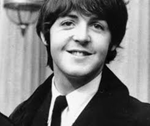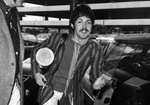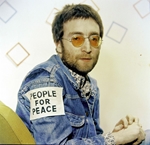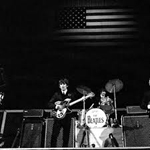- Register
- Log in to Tune-In
- Wishlist (0)
-
Shopping cart
(0)
You have no items in your shopping cart.
Beatles News

After The Beatles went their separate ways, some bad blood lingered among the former bandmates. And you saw it quickly get heated between John Lennon and Paul McCartney. On top of trading barbs in the music press, the old pals took some cracks at one another on their solo albums.
Paul took the first shot in his Ram (1971) album with a track titled “Too Many People.” With the line, “You took your lucky break and broke it in too,” he was making a clear reference to John’s relationship with Yoko Ono. And Paul did the same with the line “too many people preaching practices.”
John wasn’t going to let those statements go unanswered. And when writing songs for Imagine (1971) he saved a few haymakers for his lifelong friend. John put them all into “How Do You Sleep?,” a track which featured none other than George Harrison on slide guitar.
Source: cheatsheet.com
details
Ringo Starr’s 80th birthday is coming up on July 7th, and we’re celebrating with an in-depth conversation on the latest episode of the Rolling Stone Interview: Special Edition video series. “Man, I’m only 24 in here,” Starr says, pointing to his head. “And I’m still doing what I love to do. I’m still in the music business.”
In the interview, Starr talks about his longevity (one secret: “broccoli with everything and blueberries in the morning”); life in isolation (“I haven’t left the house in 11 weeks now”); hanging out with Keith Moon and John Bonham (“that’s two handfuls”); the early years of his solo career; Peter Jackson’s upcoming Let It Be-era Beatles documentary; missing George Harrison and John Lennon; and playing “Helter Skelter” on stage with Paul McCartney last year for the first time since he recorded it.
Starr also discussed Ringo’s Big Birthday Show, a virtual charity concert that will hit YouTube at 8 p.m. EST July 7th. The show will include a mix of at-home performances and unseen concert footage from Paul McCartney,
Source: Brian Hiatt/rollingstone.com

In our recent Happy Birthday Paul McCartney series, we did a story on his song “Two Of Us,” which is not celebrated as much as many of his songs. Despite its greatness.
So we posed the question: Do you have a favorite McCartney song you feel has been uncelebrated compared to the rest? What follows are answers we received. A wide and wonderful selection. Thank you.
But first my personal nomination to start this, “Save Us,” produced by Paul Epworth from New, 2013. Is this not great?
Paul McCartney, “Save Us”
Earl Grey
Favorite non-celebrated Macca song has to be “Beware My Love.”
“Beware My Love.”
Rich Ulloa
My favorite Paul song is “Two of Us” and my favorite “non-celebrated song would be “Goodbye,” recorded by Mary Hopkin.
Source: Paul Zollo/americansongwriter.com
details
Sir Paul McCartney’s first wife Linda was one who joined him in a huge number of endeavours. She was a member of the band Wings, and also joined him in his vegetarianism. Beatles fans were united against John Lennon’s partner, Yoko Ono – but did Linda get the same treatment?
Sir Paul met Linda Eastman, a music photographer, in 1967 at a Georgie Fame concert, where her “pushiness” worked a treat.
In Harry’s book, Linda was quoted as saying: “I was quite shameless really. I was with somebody else... and I saw Paul at the other side of the room.
“He looked so beautiful that I made up my mind I would have to pick him up.”
The pair were married in 1969, but the wedding was almost derailed according to Sir Paul.
Source: Jenny Desborough/express.co.uk
details
When you wade into debates pitting The Beatles against The Rolling Stones, the first order of business isn’t usually the guitar players. Though both Keith Richards and George Harrison rank among the best on their instrument, they worked perfectly within the confines of their respective bands.
In other words, you didn’t listen to The Beatles just to hear George play guitar, and the same went for Richards and the Stones. But it’s hard to imagine either band without these essential players on lead guitar.
Looking back on the work of George in The Beatles (and beyond), Richards spoke of how George’s style differed from that of guitar gods like Jimi Hendrix and Eric Clapton. Richards loved George’s understated, exacting approach most of all.
Source: cheatsheet.com
details
While some athletes and other celebrities have decided that they will "take a knee" while the national anthem is played at various events, now other activists, historians and journalists have actually suggested that the Star Spangled Banner be permanently replaced. The above is a copy of sheet music of :The Star-Spangled Banner" printed in 1815. Photo Credit: Library of Congress
It seems that the counter culturalists have now revved up their anti-American agenda but this time it takes a way different form than calling for the toppling of monuments and statues that offend certain folks.
While some athletes and other celebrities have decided that they will “take a knee” while the national anthem is played at various events, now other activists, historians and journalists have actually suggested that the Star Spangled Banner be permanently replaced. The reason, you ask? Because they claim that the author of the iconic anthem, Francis Scott Key was a slave owner. And therefore, the further assert, such an anthem will not resonate with black Americans and other minorities.
Source: thejewishvoice.com

If you hoped The Beatles would maintain the optimism and love songs approaching Revolver (1966), you may need felt reassured by a couple of music titles. With “Good Day Sunshine,” you’d rightfully anticipate some old style Paul McCartney optimism. And “Love You To” needed to sound promising.
But there was one other title towards the tip that certainly would have caught your eye: “Got to Get You Into My Life.” That needed to be a love music, didn’t it?Well, it was, solely Paul was singing about marijuana, not a residing particular person. In reality, Paul later referred to the monitor as “an ode to pot.”
The odes to pot didn’t finish with Revolver. When followers picked up Sgt. Pepper’s Lonely Hearts Club Band the next yr, they heard Paul sing of getting “a smoke” earlier than he “went into a dream” (in “A Day in the Life“). And “I love to turn you on” sounded drug-inspired to these within the know.
Source: Jeremy Spirogis/sahiwal.tv
details
The Beatles met in Liverpool but travelled the world together with their music. Of course, lots of time spent in close proximity can bring people together, or it can cause arguments and resentments. Certainly, there were public fall outs between members, including George Harrison and John Lennon.
Were George Harrison and John Lennon friends?
By the time of Lennon’s death, the performers were friends, according to most reports.
However, while their friendship seemed to heal over time, it certainly had its ups and downs.
One of the things which brought out arguments between them was the presence of Lennon’s second wife, Yoko Ono, in the Beatles' recording sessions.
In a 1970 interview with Rolling Stone, Lennon said: “You can quote Paul, it’s probably in the papers, he said it many times at first he hated Yoko and then he got to like her.
Source: Jenny Desborough/express.co.uk
details
John Lennon had lots to say about other people’s music. Sometimes he did his best to try to knock an artist off a pedestal. Other times, he drew attention to artists he liked who’d fallen off the radar.
Some Beatles fans get introduced to bands because John praised them. In some interviews, John strongly praised a group called Rosie and the Originals. He said they made one of his favorite songs.
John was inspired by 1950s rock ‘n’ roll. As a solo artist, he made a tribute album to that era of music simply called Rock ‘n’ Roll. According to Billboard, his girlfriend, May Pang, noted that the album included covers of songs by male icons like Little Richard, Elvis Presley, Chuck Berry, and Buddy Holly. Subsequently, Pang asked John why the album didn’t include any songs by women and mentioned he could cover “Angel Baby” by Rosie and the Originals.
Source: cheatsheet.com
details
The Beatles' September 1964 appearance at Jacksonville, Florida's Gator Bowl was historic in more ways than one. As Beatlemania rolled across the United States during the band's first American tour, Florida had been ravaged by Hurricane Dora, leaving many residents without electricity in the storm's wake. But the lasting story that month involved the Beatles' steadfast dismissal of the practices of systemic segregation that typified that era, particularly in the American South.
By that juncture, key forces were in play that would begin turning the tide on institutional racism. Only a few months earlier, as the landmark Civil Rights Act made its way through Congress, Martin Luther King, Jr., led nightly marches across St. Augustine, Florida, in protest against ongoing segregation in area schools. At the same time, there were hopeful signs of change in the offing. Later that year, King would earn a much-deserved Nobel Peace Prize for his nonviolent resistance to racism. A potent example of the era's sociopolitical shifts occurred in April 1965, when Houston's massive Astrodome opened as the first fully integrated facility of its kind in the southwest.
Source: Kenneth Womack/salon.com

The Beatles basically began as an air-tight autonomous unit. Besides a rare pre-fame credit for Tony Sheridan, their early records were presented as band efforts.
Toward the end of their time together, however, they began to welcome key outsiders into the sessions – and by the time the Beatles launched individual solo careers, the studio doors were flung wide open.
Some of those later projects don't make clear designations as to who – besides the Beatles themselves, of course – did what as sidemen. Still, their albums were dotted with key collaborators, some of them very famous.
Our list of the Top 10 Guest Performances on Beatles songs takes in both discographies, together and apart, while making some notable exceptions. We didn't include "Rockestra Theme" from Wings' 1979 album Back to the Egg, simply because it's overstuffed with guest stars – including everybody from David Gilmour and John Bonham to Ronnie Lane and Pete Townshend. There wouldn't be room for anybody else.
Source: ultimateclassicrock.com
details
Actor Danny Trejo, best known for playing movie hardass Machete, recalled the moment when the Beatles’ classic “Hey Jude” kicked off a prison riot in 1968.
He was serving 18 months in solitary confinement at the time, having built a criminal record of drug and armed-robbery offenses. Even though those days are far behind him, he can’t forget the moment one of his favorite songs caused an episode of emotion-driven violence.
“It’s always real noisy and chaotic in the hole, and this song comes on and you can barely hear it from the officer’s radio,” Trejo told NME in a new interview.. “And the hole got quiet and quiet and quiet. It’s not good when the hole is quiet. And then, ‘Judy Judy Judy Judy Judyyyyyy!’ Sinks were broken! Toilets were flooded! We went just totally insane! ... That song was so beautiful it was worth a riot.”
In 2016, he recounted a similar version of the story, telling Metal Hammer that Abbey Road was the record from his collection he wished he’d helped make. “It’s awesome,” Trejo said. “When I went to England, I walked down Abbey Road. I had to do it!”
Source: ultim details

"Our original bass player Stuart would have been 80 today! So many great memories of our time together," McCartney wrote. "Happy birthday Stu! Love Paul."
The message was accompanied by a vintage photo of The Beatles featuring Sutcliffe, McCartney, John Lennon, George Harrison, and drummer Pete Best.
Sutcliffe joined The Beatles in early 1960. He left the group the following year to focus on pursuing artistic studies in Hamburg, Germany. Sadly, he died suddenly of a brain hemorrhage in April 1962 at the age of 21.
In other news, McCartney and his daughters Mary and Stella have teamed up to support a new initiative launched by animal-rights organization PETA, calling for the U.K. to get rid of a rule that requires schools to serve meat to students on most days.
Source: 933thedrive.com
details
The 1960s were just starting to heat up by the time June 1967 rolled around, and The Beatles, like many artists of that generation, were heavily influenced by the drastic social changes taking over the Western world throughout the decade up to that point. It was on June 25th, 1967 when The Beatles—who will forever be remembered for their prominent role within pop culture as one of the key inspirations during a decade that spawned the counterculture, the civil right’s movement, and the anti-Vietnam War movement—premiered their timeless peace anthem, “All You Need Is Love” during an appearance on the Our World television special before a reported worldwide audience of 400 million people.
As the story goes, the quartet, already household names by 1967, was asked to provide a song with a universal message, as the TV special was being broadcast around the world via satellite. The band had already been working on new music to appear on the soundtrack to 1968’s Yellow Submarine, and what better time than during global broadcast to debut some new music?
Source: Tom Shackleford/liveforlivemusic.com

When The Beatles kicked off the sessions for Sgt. Pepper’s Lonely Hearts Club Band, they had decided they would become a studio band from there on out. The ill-fated Fab Four tour of 1966 convinced them that the “circus” routine their concerts had become wasn’t worth it anymore.
With live shows behind them, the band could focus solely on recording the best music they could make. And they’d never have to recreate any of the songs on stage. That was a good thing, considering a masterpiece like “A Day in the Life” would have been next-to-impossible to play live.
But that trend didn’t actually start with 1967’s Sgt. Pepper. The year before, prior to embarking on that final tour, the band had recorded its most complex work to date on Revolver (1966). And though they completed that album before the tour they never played any Revolver songs live.
Source: cheatsheet.com
details